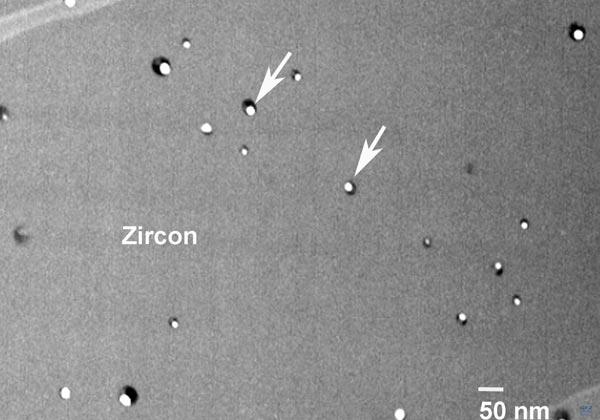Lead hokes the Age

Zircon from East Antarctica with nanospheres of metallic lead under GFZ’s transmissionelectron-microscope TEM. The rock sample is more than 3,4 billion years old. Photo: GFZ
Rocks do not loose their memory during Earth history but their true ages might be distorted: even under ultra high-temperature metamorphic conditions exceeding 1200°C zircon maintains its lead content accumulated during radioactive decay of uranium and thorium.
Giga year old zircon crystals still contain lead in form of nanometre size spheres of pure lead. However, the inhomogeneous spatial distribution of the lead spheres might falsify ages determined from high-resolution Pb isotope measurement with ion probe.
Zircon is an ideal mineral for age determination of very old rocks because it is believed to be a closed system during Earth history.
Zircon geochronology thus is a standard method of geological age determination. Recently, an international group of earth scientists studied zircon from 3,4 billion years old high-temperature metamorphic rocks from Antarctica with transmission electron microscopy TEM at the GFZ German Research Centre for Geosciences.
TEM investigations revealed that the lead from radioactive decay was not homogeneously distributed in zircon but was accumulated withinin inhomogeneously distributed Pb nano-spheres in zircon with only 5 to 30 nm in diameter.
The inhomogeneous distribution of lead in zircon might adulterate the ages measured with high-spatial resolution ion probe technique.
Monika A. Kusiak et al.: “Metallic lead nanospheres discovered in ancient zircons”, Proceedings of the National Academy of Sciences, PNAS Early Edition, 06.04.2015, DOI: doi/10.1073/pnas.1415264112
Media Contact
More Information:
http://www.gfz-potsdam.de/All latest news from the category: Earth Sciences
Earth Sciences (also referred to as Geosciences), which deals with basic issues surrounding our planet, plays a vital role in the area of energy and raw materials supply.
Earth Sciences comprises subjects such as geology, geography, geological informatics, paleontology, mineralogy, petrography, crystallography, geophysics, geodesy, glaciology, cartography, photogrammetry, meteorology and seismology, early-warning systems, earthquake research and polar research.
Newest articles

Sea slugs inspire highly stretchable biomedical sensor
USC Viterbi School of Engineering researcher Hangbo Zhao presents findings on highly stretchable and customizable microneedles for application in fields including neuroscience, tissue engineering, and wearable bioelectronics. The revolution in…

Twisting and binding matter waves with photons in a cavity
Precisely measuring the energy states of individual atoms has been a historical challenge for physicists due to atomic recoil. When an atom interacts with a photon, the atom “recoils” in…

Nanotubes, nanoparticles, and antibodies detect tiny amounts of fentanyl
New sensor is six orders of magnitude more sensitive than the next best thing. A research team at Pitt led by Alexander Star, a chemistry professor in the Kenneth P. Dietrich…





















